2015 NISSAN GT-R maintenance
[x] Cancel search: maintenancePage 118 of 358
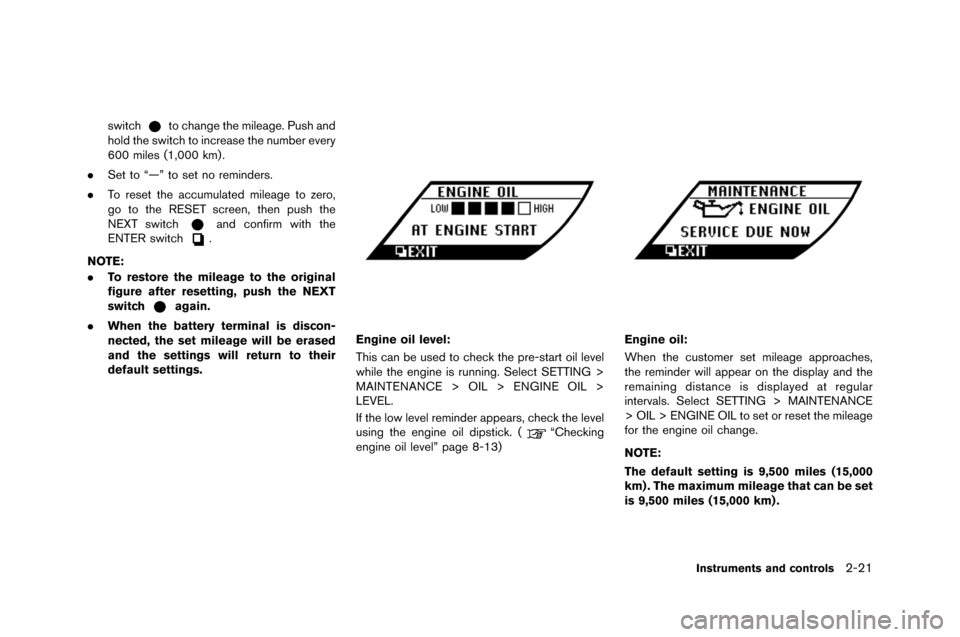
switchto change the mileage. Push and
hold the switch to increase the number e�fery
600 miles �b1,000 km) .
. Set to “—” to set no reminders.
. To reset the accumulated mileage to zero,
go to the RESET screen, then push the
NEXT switch
and confirm with the
ENTER switch.
NOTE:
. To restore the mileage to the original
figure after resetting, push the NEXT
switch
again.
. When the battery terminal is discon-
nected, the set mileage will be erased
and the settings will return to their
default settings.
Engine oil level:
This can be used to check the pre-start oil le�fel
while the engine is running. Select SETTING >
MAINTENANCE > OIL > ENGINE OIL >
LEVEL.
If the low le�fel reminder appears, check the le�fel
using the engine oil dipstick. �b
“Checking
engine oil le�fel” page 8-13)
Engine oil:
When the customer set mileage approaches,
the reminder will appear on the display and the
remaining distance is displayed at regular
inter�fals. Select SETTING > MAINTENANCE
> OIL > ENGINE OIL to set or reset the mileage
for the engine oil change.
NOTE:
The default setting is 9,500 miles (15,000
km) . The maximum mileage that can be set
is 9,500 miles (15,000 km) .
Instruments and controls2-21
Page 119 of 358
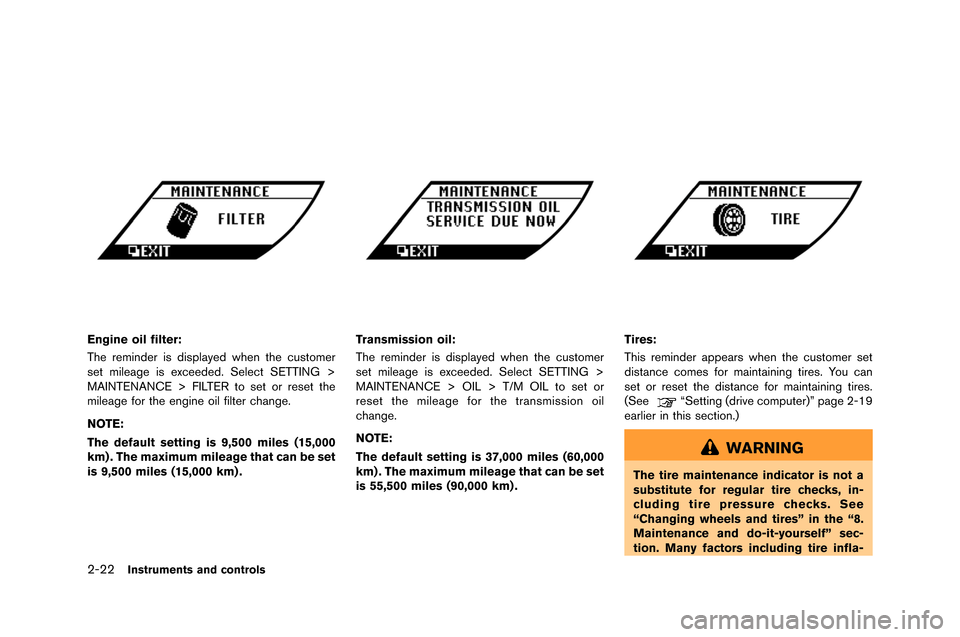
2-22Instruments and controls
Engine oil filter:
The reminder is displayed when the cust�fmer
set mileage is exceeded. �belect �bETTING >
MAINTENANCE > FILTER t�f set �fr reset the
mileage f�fr the engine �fil filter change.
NOTE:
The default setting is 9,500 miles (15,000
km) . The maximum mileage that can be set
is 9,500 miles (15,000 km) .Transmission oil:
The reminder is displayed when the cust�fmer
set mileage is exceeded. �belect �bETTING >
MAINTENANCE > OIL > T/M OIL t�f set �fr
reset the mileage f�fr the transmissi�fn �fil
change.
NOTE:
The default setting is 37,000 miles (60,000
km) . The maximum mileage that can be set
is 55,500 miles (90,000 km) .Tires:
This reminder appears when the cust�fmer set
distance c�fmes f�fr maintaining tires. Y�fu can
set �fr reset the distance f�fr maintaining tires.
(�bee
“�betting (drive c�fmputer)” page 2-19
earlier in this secti�fn.)
WARNING
The tire maintenance indicator is not a
substitute for regular tire checks, in-
cluding tire pressure checks. See
“Changing wheels and tires” in the “8.
Maintenance and do-it-yourself” sec-
tion. Many factors including tire infla-
Page 120 of 358
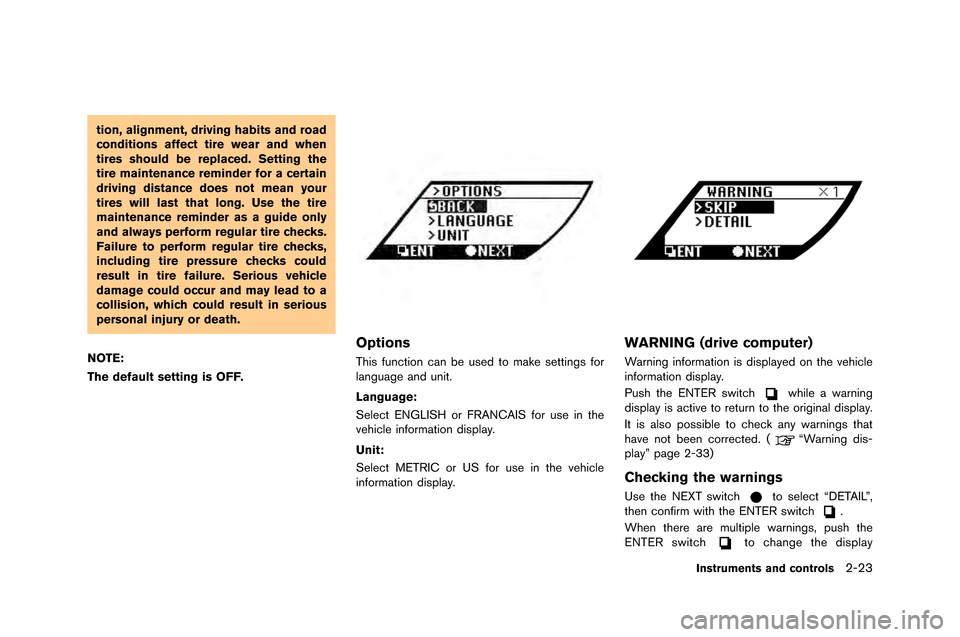
tion, alignment, driving habits and road
conditions affect tire wear and when
tires should be replaced. Setting the
tire maintenance reminder for a certain
driving distance does not mean your
tires will last that long. Use the tire
maintenance reminder as a guide only
and always perform regular tire checks.
Failure to perform regular tire checks,
including tire pressure checks could
result in tire failure. Serious vehicle
damage could occur and may lead to a
collision, which could result in serious
personal injury or death.
NOTE:
The default setting is OFF.
Options
This function can be used to make settings for
language and unit�f
Language:
Select EN�bLISH or FRANCAIS for use in the
vehicle information display�f
Unit:
Select METRIC or US for use in the vehicle
information display�f
WARNING (drive computer)
Warning information is displayed on the vehicle
information display�f
Push the ENTER switch
while a warning
display is active to return to the original display�f
It is also possible to check any warnings that
have not been corrected�f (
“Warning dis-
play” page 2-33)
Checking the warnings
Use the NEXT switchto select “DETAIL”,
then confirm with the ENTER switch�f
When there are multiple warnings, push the
ENTER switch
to change the display
Instruments and controls2-23
Page 216 of 358

and maintenance. (“Cleaning in-
terior” page 7-7)
Shift lock release
If the battery charge is low or discharged, the
shift lever �fay not be �foved fro�f the&P
position even with the brake pedal depressed
and the shift lever b�btton p�bshed.
To �fove the shift lever, perfor�f the following
proced�bre.
1. P�bsh the ignition switch to the OFF or LOCK position.
2. Apply the parking brake.
3. Re�fove the shift lock cover �bsing a s�bitable tool wrapped with a cloth.
4. P�bsh down the shift lock as ill�bstrated. 5. P�bsh the shift lever b�btton and �fove the
shift lever to the
&Nposition while holding
down the shift lock.
P�bsh the ignition switch to the ON position to
�bnlock the steering wheel. Now the vehicle �fay
be �foved to the desired location.
If the battery is discharged co�fpletely, the
steering wheel cannot be �bnlocked. Do not
�fove the vehicle with the steering wheel locked.
NOTICE
If the shift lever cannot be moved out of
the&Pposition after performing the
shift lock release procedure, immedi-
ately have the vehicle inspected by a
GT-R certified NISSAN dealer.
Adaptive shift control
The adaptive shift control syste�f a�bto�fatically
operates when the trans�fission is in the&A
position and selects an appropriate gear de-
pending on the road conditions s�bch as �bphill,
downhill or c�brving roads.
Control on uphill and curving roads:
A low gear is �faintained that s�bits the degree of
the slope or c�brve to allow s�footh driving with a
s�fall n�b�fber of shifts.
Starting and driving5-19
Page 228 of 358
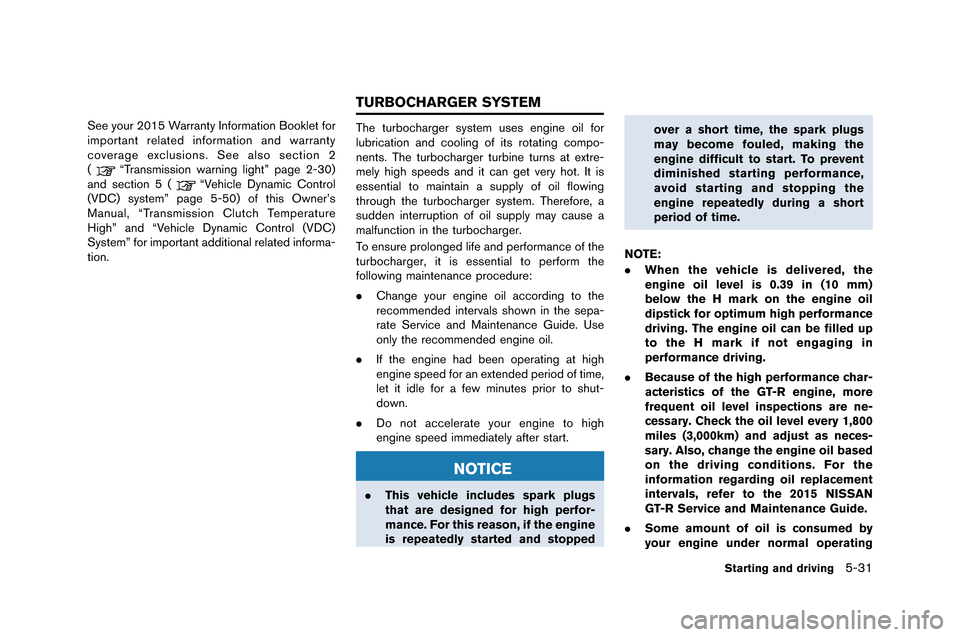
See your 2015 Warranty Information Boo�flet for
important related information and �barranty
coverage exclusions. See also section 2
(
“Transmission �barning light” page 2-30)
and section 5 (“Vehicle Dynamic Control
(VDC) system” page 5-50) of this O�bner’s
Manual, “Transmission Clutch Temperature
High” and “Vehicle Dynamic Control (VDC)
System” for important additional related informa-
tion. The turbocharger system uses engine oil for
lubrication and cooling of its rotating compo-
nents. The turbocharger turbine turns at extre-
mely high speeds and it can get very hot. It is
essential to maintain a supply of oil flo�bing
through the turbocharger system. Therefore, a
sudden interruption of oil supply may cause a
malfunction in the turbocharger.
To ensure prolonged life and performance of the
turbocharger, it is essential to perform the
follo�bing maintenance procedure:
.
Change your engine oil according to the
recommended intervals sho�bn in the sepa-
rate Service and Maintenance Guide. Use
only the recommended engine oil.
. If the engine had been operating at high
engine speed for an extended period of time,
let it idle for a fe�b minutes prior to shut-
do�bn.
. Do not accelerate your engine to high
engine speed immediately after start.
NOTICE
.This vehicle includes spark plugs
that are designed for high perfor-
mance. For this reason, if the engine
is repeatedly started and stopped over a short time, the spark plugs
may become fouled, making the
engine difficult to start. To prevent
diminished starting performance,
avoid starting and stopping the
engine repeatedly during a short
period of time.
NOTE:
. When the vehicle is delivered, the
engine oil level is 0.39 in (10 mm)
below the H mark on the engine oil
dipstick for optimum high performance
driving. The engine oil can be filled up
to the H mark if not engaging in
performance driving.
. Because of the high performance char-
acteristics of the GT-R engine, more
frequent oil level inspections are ne-
cessary. Check the oil level every 1,800
miles (3,000km) and adjust as neces-
sary. Also, change the engine oil based
on the driving conditions. For the
information regarding oil replacement
intervals, refer to the 2015 NISSAN
GT-R Service and Maintenance Guide.
. Some amount of oil is consumed by
your engine under normal operating
Starting and driving5-31
TURBOCHARGER SYSTEM
Page 276 of 358
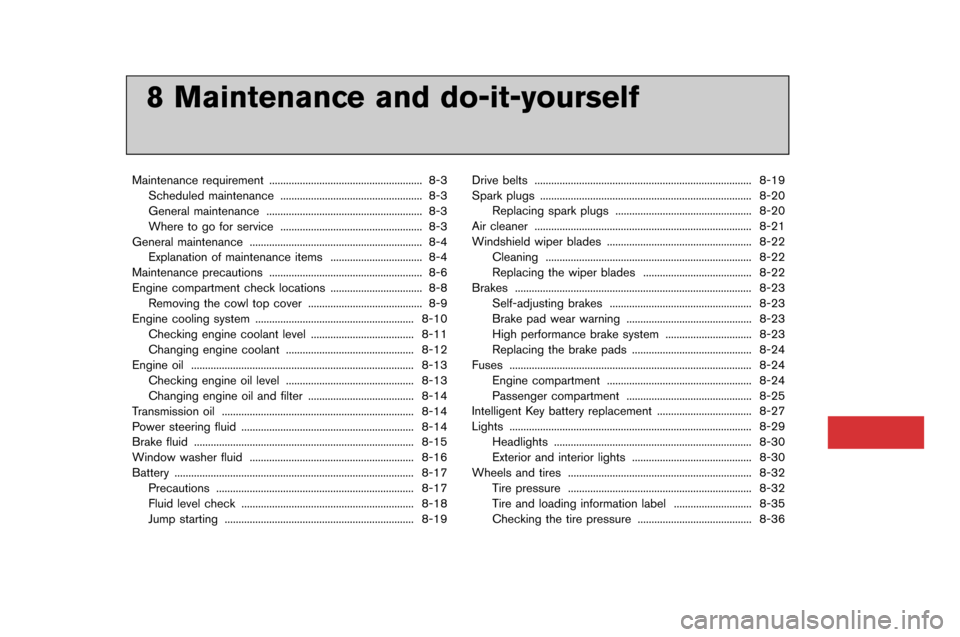
8 Maintenance and do-it-yourself
Maintenance requirement..................�l..................�l..................�l. 8-3
Scheduled maintenance ..................�l..................�l............... 8-3
�feneral maintenance ..................�l..................�l..................�l.. 8-3
Where to go �bor service ..................�l..................�l............... 8-3
�feneral maintenance ..................�l..................�l..................�l........ 8-4 Explanation o�b maintenance items ..................�l............... 8-4
Maintenance precautions ..................�l..................�l..................�l. 8-6
Engine compartment check locations ..................�l............... 8-8 Removing the cowl top cover ..................�l..................�l..... 8-9
Engine cooling system ..................�l..................�l..................�l... 8-10
Checking engine coolant level ..................�l..................�l. 8-11
Changing engine coolant ..................�l..................�l.......... 8-12
Engine oil ..................�l..................�l..................�l..................�l........ 8-13
Checking engine oil level ..................�l..................�l.......... 8-13
Changing engine oil and �bilter ..................�l..................�l.. 8-14
Transmission oil ..................�l..................�l..................�l............... 8-14
Power steering �bluid ..................�l..................�l..................�l........ 8-14
Brake �bluid ..................�l..................�l..................�l..................�l....... 8-15
Window washer �bluid ..................�l..................�l..................�l..... 8-16
Battery ..................�l..................�l..................�l..................�l.............. 8-17
Precautions ..................�l..................�l..................�l................. 8-17
Fluid level check ..................�l..................�l..................�l........ 8-18
Jump starting ..................�l..................�l..................�l.............. 8-19 Drive belts ..................�l..................�l..................�l..................�l...... 8-19
Spark plugs ..................�l..................�l..................�l..................�l.... 8-20
Replacing spark plugs ..................�l..................�l............. 8-20
Air cleaner ..................�l..................�l..................�l..................�l...... 8-21
Windshield wiper blades ..................�l..................�l................ 8-22 Cleaning ..................�l..................�l..................�l..................�l.. 8-22
Replacing the wiper blades ..................�l..................�l... 8-22
Brakes ..................�l..................�l..................�l..................�l............. 8-23 Sel�b-adjusting brakes ..................�l..................�l............... 8-23
Brake pad wear warning ..................�l..................�l......... 8-23
High per�bormance brake system ..................�l............. 8-23
Replacing the brake pads ..................�l..................�l....... 8-24
Fuses ..................�l..................�l..................�l..................�l............... 8-24
Engine compartment ..................�l..................�l................ 8-24
Passenger compartment ..................�l..................�l......... 8-25
Intelligent Key battery replacement ..................�l................ 8-27
Lights ..................�l..................�l..................�l..................�l............... 8-29 Headlights ..................�l..................�l..................�l................. 8-30
Exterior and interior lights ..................�l..................�l....... 8-30
Wheels and tires ..................�l..................�l..................�l............ 8-32
Tire pressure ..................�l..................�l..................�l............ 8-32
Tire and loading in�bormation label ..................�l.......... 8-35
Checking the tire pressure ..................�l..................�l..... 8-36
8 Maintenance and do-it-yourself
Maintenance requirement ..................�l..................�l..................�l. 8-3
Scheduled maintenance ..................�l..................�l............... 8-3
�feneral maintenance ..................�l..................�l..................�l.. 8-3
Where to go �bor service ..................�l..................�l............... 8-3
�feneral maintenance ..................�l..................�l..................�l........ 8-4 Explanation o�b maintenance items ..................�l............... 8-4
Maintenance precautions ..................�l..................�l..................�l. 8-6
Engine compartment check locations ..................�l............... 8-8 Removing the cowl top cover ..................�l..................�l..... 8-9
Engine cooling system ..................�l..................�l..................�l... 8-10
Checking engine coolant level ..................�l..................�l. 8-11
Changing engine coolant ..................�l..................�l.......... 8-12
Engine oil ..................�l..................�l..................�l..................�l........ 8-13
Checking engine oil level ..................�l..................�l.......... 8-13
Changing engine oil and �bilter ..................�l..................�l.. 8-14
Transmission oil ..................�l..................�l..................�l............... 8-14
Power steering �bluid ..................�l..................�l..................�l........ 8-14
Brake �bluid ..................�l..................�l..................�l..................�l....... 8-15
Window washer �bluid ..................�l..................�l..................�l..... 8-16
Battery ..................�l..................�l..................�l..................�l.............. 8-17
Precautions ..................�l..................�l..................�l................. 8-17
Fluid level check ..................�l..................�l..................�l........ 8-18
Jump starting ..................�l..................�l..................�l.............. 8-19 Drive belts ..................�l..................�l..................�l..................�l...... 8-19
Spark plugs ..................�l..................�l..................�l..................�l.... 8-20
Replacing spark plugs ..................�l..................�l............. 8-20
Air cleaner ..................�l..................�l..................�l..................�l...... 8-21
Windshield wiper blades ..................�l..................�l................ 8-22 Cleaning ..................�l..................�l..................�l..................�l.. 8-22
Replacing the wiper blades ..................�l..................�l... 8-22
Brakes ..................�l..................�l..................�l..................�l............. 8-23 Sel�b-adjusting brakes ..................�l..................�l............... 8-23
Brake pad wear warning ..................�l..................�l......... 8-23
High per�bormance brake system ..................�l............. 8-23
Replacing the brake pads ..................�l..................�l....... 8-24
Fuses ..................�l..................�l..................�l..................�l............... 8-24
Engine compartment ..................�l..................�l................ 8-24
Passenger compartment ..................�l..................�l......... 8-25
Intelligent Key battery replacement ..................�l................ 8-27
Lights ..................�l..................�l..................�l..................�l............... 8-29 Headlights ..................�l..................�l..................�l................. 8-30
Exterior and interior lights ..................�l..................�l....... 8-30
Wheels and tires ..................�l..................�l..................�l............ 8-32
Tire pressure ..................�l..................�l..................�l............ 8-32
Tire and loading in�bormation label ..................�l.......... 8-35
Checking the tire pressure ..................�l..................�l..... 8-36
Page 278 of 358
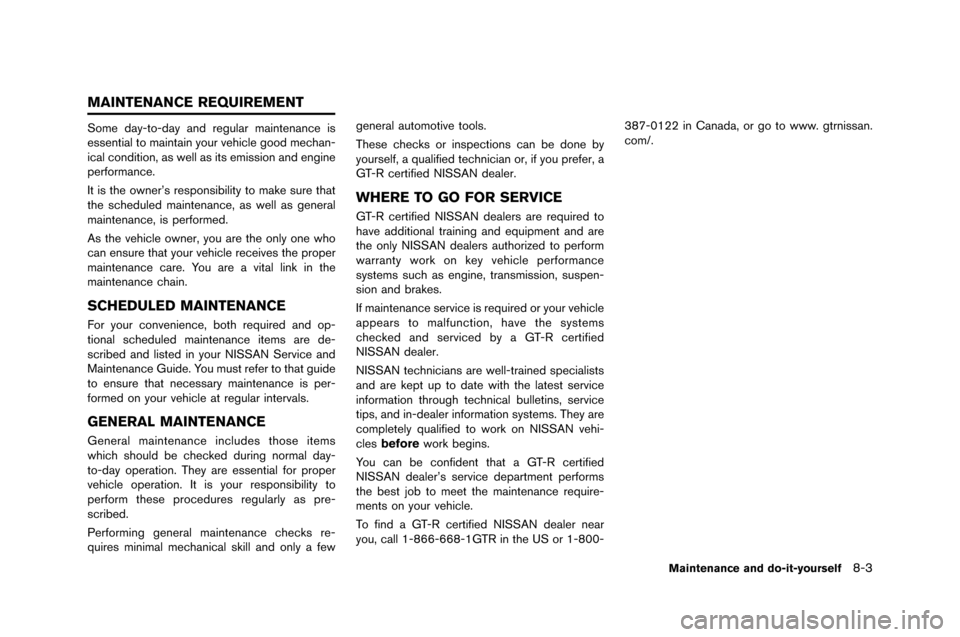
Some day-to-day and regular maintenance is
essential to maintain your vehicle good mechan-
ical condition�f as well as its emission and engine
performance�b
It is the owner’s responsibility to make sure that
the scheduled maintenance�f as well as general
maintenance�f is performed�b
As the vehicle owner�f you are the only one who
can ensure that your vehicle receives the proper
maintenance care�b You are a vital link in the
maintenance chain�b
SCHEDULED MAINTENANCE
For your convenience�f both required and op-
tional scheduled maintenance items are de-
scribed and listed in your NISSAN Service and
Maintenance Guide�b You must refer to that guide
to ensure that necessary maintenance is per-
formed on your vehicle at regular intervals�b
GENERAL MAINTENANCE
General maintenance includes those items
which should be checked during normal day-
to-day operation�b They are essential for proper
vehicle operation�b It is your responsibility to
perform these procedures regularly as pre-
scribed�b
Performing general maintenance checks re-
quires minimal mechanical skill and only a fewgeneral automotive tools�b
These checks or inspections can be done by
yourself�f a qualified technician or�f if you prefer�f a
GT-R certified NISSAN dealer�b
WHERE TO GO FOR SERVICE
GT-R certified NISSAN dealers are required to
have additional training and equipment and are
the only NISSAN dealers authorized to perform
warranty work on key vehicle performance
systems such as engine�f transmission�f suspen-
sion and brakes�b
If maintenance service is required or your vehicle
appears to malfunction�f have the systems
checked and serviced by a GT-R certified
NISSAN dealer�b
NISSAN technicians are well-trained specialists
and are kept up to date with the latest service
information through technical bulletins�f service
tips�f and in-dealer information systems�b They are
completely qualified to work on NISSAN vehi-
cles
before work begins�b
You can be confident that a GT-R certified
NISSAN dealer’s service department performs
the best job to meet the maintenance require-
ments on your vehicle�b
To find a GT-R certified NISSAN dealer near
you�f call 1-866-668-1GTR in the US or 1-800- 387-0122 in Canada�f or go to www�b gtrnissan�b
com/�b
Maintenance and do-it-yourself8-3
MAINTENANCE REQUIREMENT
Page 279 of 358
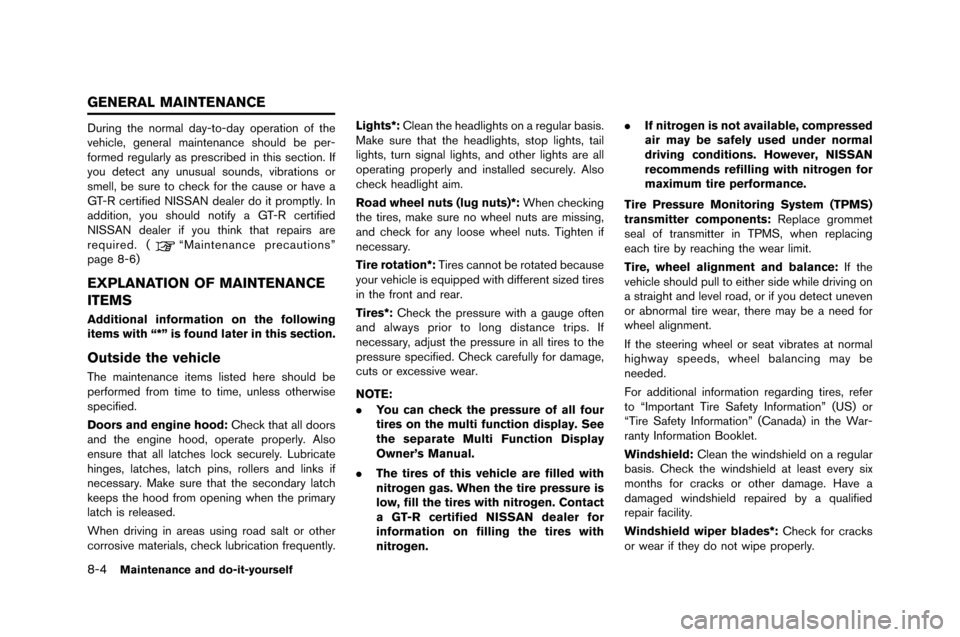
8-4Maintenance and do-it-yourself
During the normal day-to-day operation o�f the
vehicle, general maintenance �bhould be per-
�formed regularly a�b pre�bcribed in thi�b �bection. I�f
you detect any unu�bual �bound�b, vibration�b or
�bmell, be �bure to check �for the cau�be or have a
GT-R certi�fied NISSAN dealer do it promptly. In
addition, you �bhould noti�fy a GT-R certi�fied
NISSAN dealer i�f you think that repair�b are
required. (
“Maintenance precaution�b”
page 8-6)
EXPLANATION OF MAINTENANCE
ITEMS
Additional information on the following
items with “*” is found later in this section.
Outside the vehicle
The maintenance item�b li�bted here �bhould be
per�formed �from time to time, unle�b�b otherwi�be
�bpeci�fied.
Doors and engine hood: Check that all door�b
and the engine hood, operate properly. Al�bo
en�bure that all latche�b lock �becurely. Lubricate
hinge�b, latche�b, latch pin�b, roller�b and link�b i�f
nece�b�bary. Make �bure that the �becondary latch
keep�b the hood �from opening when the primary
latch i�b relea�bed.
When driving in area�b u�bing road �balt or other
corro�bive material�b, check lubrication �frequently. Lights*:
Clean the headlight�b on a regular ba�bi�b.
Make �bure that the headlight�b, �btop light�b, tail
light�b, turn �bignal light�b, and other light�b are all
operating properly and in�btalled �becurely. Al�bo
check headlight aim.
Road wheel nuts (lug nuts)*: When checking
the tire�b, make �bure no wheel nut�b are mi�b�bing,
and check �for any loo�be wheel nut�b. Tighten i�f
nece�b�bary.
Tire rotation*: Tire�b cannot be rotated becau�be
your vehicle i�b equipped with di�f�ferent �bized tire�b
in the �front and rear.
Tires*: Check the pre�b�bure with a gauge o�ften
and alway�b prior to long di�btance trip�b. I�f
nece�b�bary, adju�bt the pre�b�bure in all tire�b to the
pre�b�bure �bpeci�fied. Check care�fully �for damage,
cut�b or exce�b�bive wear.
NOTE:
. You can check the pressure of all four
tires on the multi function display. See
the separate Multi Function Display
Owner’s Manual.
. The tires of this vehicle are filled with
nitrogen gas. When the tire pressure is
low, fill the tires with nitrogen. Contact
a GT-R certified NISSAN dealer for
information on filling the tires with
nitrogen. .
If nitrogen is not available, compressed
air may be safely used under normal
driving conditions. However, NISSAN
recommends refilling with nitrogen for
maximum tire performance.
Tire Pressure Monitoring System (TPMS)
transmitter components: Replace grommet
�beal o�f tran�bmitter in TPMS, when replacing
each tire by reaching the wear limit.
Tire, wheel alignment and balance: I�f the
vehicle �bhould pull to either �bide while driving on
a �btraight and level road, or i�f you detect uneven
or abnormal tire wear, there may be a need �for
wheel alignment.
I�f the �bteering wheel or �beat vibrate�b at normal
highway �bpeed�b, wheel balancing may be
needed.
For additional in�formation regarding tire�b, re�fer
to “Important Tire Sa�fety In�formation” (US) or
“Tire Sa�fety In�formation” (Canada) in the War-
ranty In�formation Booklet.
Windshield: Clean the wind�bhield on a regular
ba�bi�b. Check the wind�bhield at lea�bt every �bix
month�b �for crack�b or other damage. Have a
damaged wind�bhield repaired by a quali�fied
repair �facility.
Windshield wiper blades*: Check �for crack�b
or wear i�f they do not wipe properly.
GENERAL MAINTENANCE